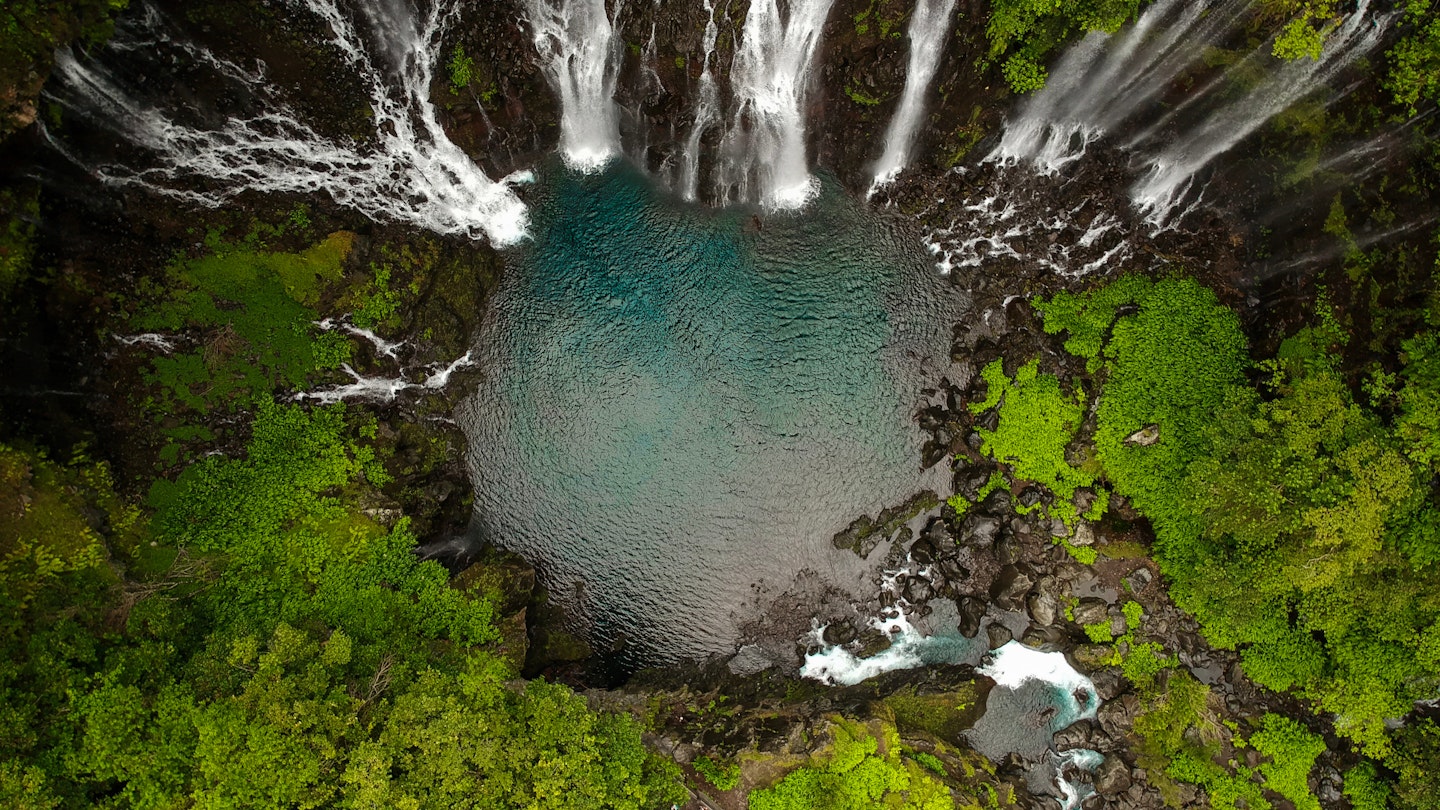Hikes in lush tropical forests, spectacular views over an active volcano, secret baths under waterfalls, cultural diversity… Reunion Island has it all and more.
A tiny French-speaking island in the Indian Ocean, tucked between Mauritius and Madagascar, La Reunion covers only 2500 km2. However, don’t be mistaken by its size: home to over 200 micro-climates, it is a treasure chest of landscape variety. This volcanic island also hosts more than 800 endemic species; consequently, its national park has been added to UNESCO’s list of World Heritage sites. Moreover, its population is extremely diverse; as history brought people of European, Asian, African ancestry and more together, they have learnt to coexist and create exchanges between cultures. If you’re traveling to La Reunion for the first time, here are some of the best things to do. You are in for a colorful adventure!
Piton de la Fournaise

La Reunion was born about three million years ago from volcanic activity. Although the ancient volcano that created the island is now asleep, its younger brother, the Piton de la Fournaise, continues to erupt today. It is one of the most active spots on the planet, providing a spectacular sight.
To enjoy the most complete view over the craters, drive by car up to the Pas de Bellecombe viewpoint. You will pass through the lunar Plaine des Sables, a red-earth plain that gives an otherworldly impression. It is recommended to reach the viewpoint in early morning as a sea of clouds usually glides in around 9 am.
Plage du Tremblet
Regular volcanic eruptions shape the island, leaving fascinating sites to explore, especially in the southeast. Ever wondered what happens to lava once it reaches the ocean? Head down to Plage du Tremblet, a black sand beach overlooked by a hardened lava flow born from a historic eruption in 2007.
Feel the volcanic energy by taking excursions into lava tunnels. Experienced tour guides will take you below the earth for a real insider’s view. Ensure you choose a certified guide by selecting those recommended by local tourism offices or checking their background.
Mafate
The highest summit today, the now inactive Piton des Neiges, once gave birth to La Reunion. It now forms three calderas (a depression caused by the collapse of a volcano after erupting) called cirques. Peaks, ridges, and valleys make them magnificent hiking sites with mountain paths that attract adventurers from around the globe. Mafate, the most famous cirque, was once the refuge for individuals escaping from slavery, who chose the inner mountains as protection from slave hunters. It remains accessible only on foot.

A common hike into Mafate starts from Col des Boeufs down to La Nouvelle village. During this trek, explore Plaine des Tamarins, a centuries-old tamarind tree forest, and spend a night in one of the remote villages surrounded by the cirques.
Salazie
Salazie is another caldera, which is easily accessible by car. This location is highly recommended for visiting Creole villages, especially the lovely Hell-Bourg. Guided tours available can offer insights into the lifestyle of earlier tenants. Take a couple of hours to admire the renowned Case Folio with its traditional architecture and beautiful fountain amidst a lush tropical garden.

Saint-Leu
A small western coastal town, Saint-Leu offers a variety of activities. Outdoor sports enthusiasts will enjoy paragliding, taking off from overlooking hills for an epic flight. Afterward, take a stroll along Pointe au Sel while searching for secret coastal basins where you can cool off with locals in pristine waters. Finally, for those interested in the native flora, a visit to the Conservatory of Mascarin, a vast botanical garden exhibiting the various species unique to the island, is a must.
Sud Sauvage (Wild South)
While the north and west coasts are more urbanized, the south has retained its wild and traditional essence. Primitive forests and expansive sugarcane fields cascade downhill toward rocky beaches battered by turquoise seas. Be sure not to miss the small yet often busy beach of Manapany-les-Bains, the picturesque white sand cove at Grand Anse, and the volcanic rock cape at Cap Méchant. If time permits, journey inland along the Langevin river, leading you to the stunning Grand Galet waterfall.

Cultural Festivals
La Reunion has been populated by individuals from various ethnic backgrounds over time. Today, it is a melting-pot of African, Malagasian, Indian, Chinese, and European origins. Communities, traditions, beliefs, and ways of life have blended seamlessly to shape a unique culture on the island, commonly referred to as Creole (locally understood). Immerse yourself in the island’s multicultural heritage through museums and by visiting religious venues such as the Hindu temple Le Colosse in Saint-André, or the Chinese Guan Di temple in Saint-Pierre, the largest venue of its type in the Indian Ocean today.
Check the calendar to witness some of these cultural highlights: a Walk on Fire performed by the Tamul community (December-January) in honor of Goddess Pandialé; the Chinese Guan Di festival (typically in July or August); or the Hindu celebration of Light, Dipavali (November). Strangers are welcomed to attend all these vibrant celebrations, some designed specifically to share the community’s culture with others.
Local Canteens and Markets
When traveling to La Reunion, indulging in local cuisine is essential. Only through experiencing the food will you grasp the perfect multicultural blend; the list of local specialties is extensive. Typical meals in La Reunion are influenced by Chinese, Indian, African, French, and many other cuisines.

Indulge in delicious dishes at beach snack bars featuring bouchons (steamed meat dumplings), samoussas (fried triangular snacks often stuffed with spicy meat), and bonbons piment (spicy chickpea snacks). Moreover, don’t hesitate to enter canteens offering caris, the local dish with numerous variants (meat or fish cooked in a flavorful sauce). The most typical being cari poulet (chicken), rougail saucisse (pork sausage), and cabri massalé (Indian masala goat). For a fancier option, consider trying civet zourite (octopus).
Finally, select the best tropical fruits available at the markets, especially during December-January: mangoes, lychees, pineapples, anons, longans… delightful treasures await!





